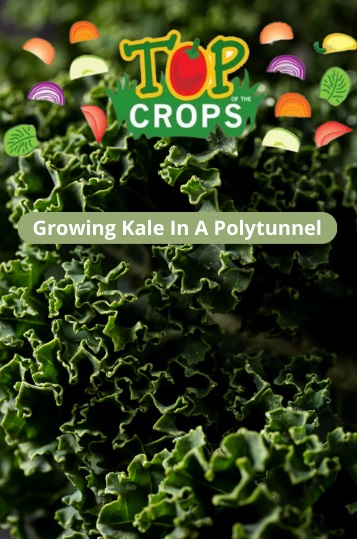Kale, a member of the cabbage family, is a hardy and nutritious plant that can be a valuable food source over the winter months. Kale is in the Ancephala group of Brassica oleracea derived from wild mustard. It has been cultivated for food since at least 2000 BCE.
You certainly do not need a polytunnel to grow this hardy, healthy and resilient leafy vegetable. But a polytunnel can make growing kale even easier, in some respects, than it is outdoors. While kale is usually grown as a winter crop, you can actually harvest kale in one form or another throughout the whole of the year.
Kale is usually considered as an annual/ biennial crop but you should note that there are also some perennial types, that you will be able to harvest not only for a single season but over several years. Kale can often perennialize in the UK and produce well for several seasons.
Kale likes a full sun position but will also do perfectly well in light shade. It is a cool season crop which does not like extreme heat but which can cope well with lower temperatures.
Kale requires a rich, firm, and moist but well-drained soil that is rich in organic matter.
| Jan | Feb | Mar | Apr | May | Jun | Jul | Aug | Sep | Oct | Nov | Dec | |
| Sow |  |
 |
 |
 |
||||||||
| Plant |  |
 |
 |
|||||||||
| Harvest |  |
 |
 |
 |
 |
 |
 |
Sow kale thinly between March and June where it is to grow or, from March, sow seeds indoors and transplant kale seedlings to their final growing position when their first few true leaves have formed.
Sowing indoors can be a good option where delicate young seedlings are lost to pests. Cloches can help protect seedlings while they are still small.
Seedlings should be placed, or thinned to around 7.5cm apart initially and then thinned to or placed at a final spacing of around 45cm between plants for full-sized specimens, though you can place kale much more closely if you plan on harvesting micro-greens or baby kale rather than harvesting more mature leaves.
Once it begins to mature, kale is a hardy crop that is largely able to take care of itself when it is placed in the right location. However, with the right care (see below) you can increase your yields and ensure that your kale plants are as healthy as possible.
It all begins with finding the right location for your kale plants, and deciding how this crop will fit into your overall garden plans.
If you would like to grow kale then of course you need to give some careful thought not only to which variety to grow- a topic we will cover later in this guide – but also where you will grow this crop.
Kale is typically direct sowed in a garden where it is to grow between March and June, or sowed indoors and transplanted to the garden from April to June. Later sowings in July or August are also sometimes possible with a polytunnel. And all year round kale can be sown into pots or undercover beds for baby leaves or micro-greens.
Remember that kale will thrive in full sun or light shade, in a moist yet well-drained soil or growing medium.
You can grow it outside in your garden in the ground or in a raised bed. You can grow kale in a polytunnel or other undercover area. It can be grown in a range of different containers and can even be grown indoors on a sunny windowsill.
As mentioned above, spacing for kale depends on the stage at which you plan to harvest your crop. For full sized leaves, kale plants should be positioned at or thinned to 45cm intervals.
However, if you plan on harvesting kale for young leaves for salads etc. then thinning will not always be needed if you direct sowed, and transplants can be placed much closer together.
When planting out any kale plants, remember that these should be hardened off when being moved from indoors. Remember, also, that the plants should be placed at the right depth in their new positions. The lowest leaves of your kale plant should be only just above the soil surface.
When planting, make sure that you firm the soil well around the base of the plant to prevent future issues with wind-rock and damage.
Kale is most commonly grown from seed, and you may be able to consider saving your own. It can also be propagated from cuttings with a specific propagation process.
To propagate new kale plants from cuttings:
Select a side shoot with multiple leaves growing out from the side of the main stem.
Remove the leaves from the lower half of the cutting and trim the bottom of the stem immediately below a leaf node at a 45 degree angle.
Dip the end of the cutting in an organic rooting hormone to increase the chances of success.
Place the cutting into a pot with a suitable cuttings potting mix and drainage holes at the base.
Keep the soil moist and keep in a reasonably light and cool location until the cutting roots.
Once the cutting has rooted successfully it can be transplanted/ planted out as above.
Kale can be harvested as a cut and come again crop for salads and stir fries, or left to mature and used in the same way as other cabbages.
Usually, it is best to remove young leaves from the top of the plant from October onwards and then to continue to harvest as needed over the winter. Kale is at its best when harvested after the leaves have been exposed to frost.
As a cut and come again crop, however, for micro-greens or baby leaves, you can begin to harvest at any much earlier stage. Further young leaves will be formed which can also be harvested in turn.
There are plenty of ways to use kale in the kitchen. One child-friendly kale recipe is kale crisps, made in the oven. This is a great way to get some nutrition into those who are not so keen to eat their greens.
Kale will keep in your fridge for a few days, but is best eaten as soon after harvesting as possible so that it retains as many nutrients as possible. Fortunately, there are plenty of kale recipes to consider to make the most of this crop. Kale can also be blanched and frozen, or dried for later use.
Kale is one of the easiest crops to care for – a great choice for beginners. Wherever and however you have chosen to grow it, you should find that you get a good harvest without too much trouble, as long as you bear the basics in mind.
Puddle in plants upon planting out with plenty of water and continue to provide plenty of water over the growing season. Kale does not like to dry out too much, but equally, does not like waterlogging so make sure excess water can always drain away freely.
Remember that healthy soil equals healthy plants. Mulching, see below, will help to maintain soil health and improve the soil where you live, as will other organic gardening strategies such as companion planting and crop rotation.
A nitrogen rich organic mulch will help to conserve soil moisture around your plants and will also encourage good, leafy growth. Grass clippings and good quality compost make a good mulch for kale and other brassicas.
As a brassica, kale will benefit from nitrogen fixing plants sown nearby. Kale will also grow well as a companion crop for beetroots and spinach, amongst other crops. Companion planting can keep kale healthy and in tip top condition.
Onions and other Alliums, nasturtiums and thyme are among the many plants that may benefit kale by reducing the incidence of some pests, to give a few examples.
To ensure that there is not too much competition for water and nutrients, keep on top of weeds around these brassica plants. But remember that weeds are not always the enemy and some weeds may even be beneficial companion plants for your kale crop. Chickweed can potentially be a good groundcover plant, for example.
As mentioned above, it is important to firm the soil well around kale plants upon planting. But in addition, some taller varieties may also benefit from support from a stake, or bamboo cane, to which the plant can be tied to prevent damage in stormy, windy, wintery weather.
It is not usually necessary to prune kale though it can sometimes be beneficial to remove any dead or damaged leaves or any suffering from disease promptly, to prevent issues from spreading, and to encourage healthy new growth.
Some highly regarded varieties of kale to consider growing in the UK are:
‘Black Magic’
'Cavolo nero'
‘Kapitan’
‘Redbor’
‘Reflex’
‘Starbor’
‘Winterbor’
‘Yurok’
Kale is a brassica, a member of the cabbage family, and so can fall prey to many of the same issues as its close cabbage relatives.
Problems include being eaten by birds, rodents, or caterpillars, or suffering an infestation of cabbage root flies. Covering your crop can prevent cabbage white butterflies from laying their eggs and deliver a physical barrier for protection. A row cover or cloche with insect-proof mesh is a good idea, even inside a polytunnel, since the polytunnel doors and vents will need to be open in summer.
Remember that managing pests in an organic garden also means aiming for as high a biodiversity as possible and attracting beneficial wildlife to your garden through companion planting and habitat creation.
Kale can be grown outside throughout the winter in much of the UK. If, however, you would like to be able to harvest kale in winter weather without frost and snow, or have a problem with birds eating your crop then a polytunnel can be a great option. A polytunnel will protect kale from the worst winter weather excesses and ensure you have a good stock of this healthy vegetable right through until spring.
Pratyush, R., (2024) Spinach vs Kale: Which leafy green is healthier? India TV. [online] Available at: https://www.indiatvnews.com/lifestyle/food/spinach-vs-kale-which-leafy-green-is-healthier-2024-01-02-909952
